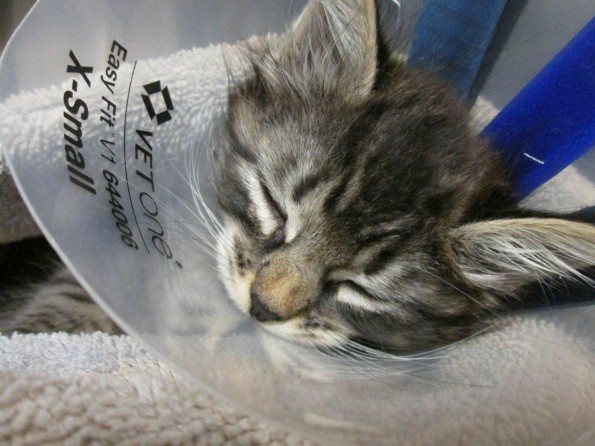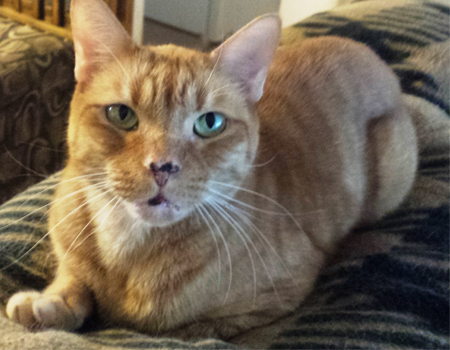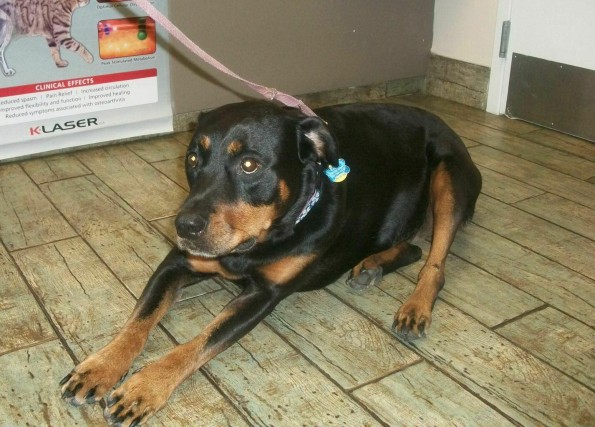
Abbie
A little Pekingese named Abbie came into All Pet Care Hospital when she began squinting and rubbing her eye. Little did she know that she

A little Pekingese named Abbie came into All Pet Care Hospital when she began squinting and rubbing her eye. Little did she know that she

Stitches might not seem like a name someone would give a tiny kitten, but it fits this little tabby girl more than you might imagine.

Magnolia (Maggie) Kimble was not herself when she came in to All Pet Care Hospital. This bubbly Golden Retriever had not wanted to eat for

In veterinary medicine, sometimes the most interesting cases come from our own pets. The curious sight of a cat in a diaper might have you

Every other Saturday, there are a couple of very familiar faces found at All Pet Care Hospital, an 8 year old Rottweiler Maggie and her

Late at night on October 29th, 2014 a frantic couple brought their sweet 16 year old dog into our clinic. She had been attacked by
 A little Pekingese named Abbie came into All Pet Care Hospital when she began squinting and rubbing her eye. Little did she know that she would soon have ‘Frankenstein eyes’ that glowed green under a black light in the clinic. Don’t worry though Abbie is no monster; Abbie’s eyes glowed because of the drops Dr. Rixford put in to check her eyes for corneal ulcers, called fluorescein stain drops.
A little Pekingese named Abbie came into All Pet Care Hospital when she began squinting and rubbing her eye. Little did she know that she would soon have ‘Frankenstein eyes’ that glowed green under a black light in the clinic. Don’t worry though Abbie is no monster; Abbie’s eyes glowed because of the drops Dr. Rixford put in to check her eyes for corneal ulcers, called fluorescein stain drops.
Abbie did indeed have a scratch which glowed under blacklight, and showed a black spot in the middle of the scratch like a bullseye meaning that the ulcer went far down into the cornea, called a descemetocele. A descemetocele means that the ulcer is one small cell layer away from being inside of the eye. This is very dangerous as there is a great likelihood of complete perforation of the eye, and therefore loss of the eye from the inner liquid coming through. Deep ulcers can also cause permanent scarring of the cornea.
Corneal ulcers are common among pets, especially those that are more playful with other pets. The most common cause of ulcers in most animals is trauma to the eye, such as a scratch or abrasion. Corneal ulcers are very painful, and can cause the pet to squint or close the eye entirely, and often owners see discharge around the eye. The severity of the ulcer depends upon how far into the eye the trauma goes. There are multiple cell layers to the eye, so the more layers in, the harder the ulcer is to treat and to heal. Medications need to be used both to prevent infection and to help the eye to heal.
Dr. Rixford told Abbie’s dad that he might have to get Abbie’s eye seen by a veterinary Ophthalmologist or potentially have the eye removed because of how bad the ulcer was. The other option was to medicate the eye and hope that it healed correctly. Abbie’s dad had to work diligently; giving three different eye medications every day and continuing to come for recheck visits so Dr. Rixford could stain the eye and make sure the ulcer was healing. She also had to wear an e-collar, or cone collar, to make sure she didn’t rub or irritate her eye further. After a little over a month Abbie’s ulcer was healed and she was cleared to play again. Hopefully she is careful now!
If you are concerned that your pet has scratched or irritated an eye, contact us today.
 Stitches might not seem like a name someone would give a tiny kitten, but it fits this little tabby girl more than you might imagine. Stitches was brought to All Pet Care before she even had a name, and before her family knew if they would be able to keep her. They found her on the ground after possibly being run over by a car. They knew she was hurt, and could see blood coming from her mouth, so they rushed to the hospital to see if anything could be done to help her.
Stitches might not seem like a name someone would give a tiny kitten, but it fits this little tabby girl more than you might imagine. Stitches was brought to All Pet Care before she even had a name, and before her family knew if they would be able to keep her. They found her on the ground after possibly being run over by a car. They knew she was hurt, and could see blood coming from her mouth, so they rushed to the hospital to see if anything could be done to help her.
When Dr. Rixford did her exam, she noticed that the skin on Stitches chin had been torn off, or “degloved,” meaning that skin is torn away from the tissue underneath. Luckily for Stitches, the skin had only opened, instead of being completely taken off, so Dr. Rixford sutured the skin back on Stitches chin.
The procedure went well for the scared little kitten. She had to have an e-collar (cone collar) on to keep from scratching at her mouth, and her family took her home with antibiotics to keep infection from setting in, as well as pain medication. Stitches was back to being a normal little kitten in no time. She has since grown from the one and a half pound peanut that first came in. She even has a brother now, named Tano, who is just a couple weeks younger than her!
 Magnolia (Maggie) Kimble was not herself when she came in to All Pet Care Hospital. This bubbly Golden Retriever had not wanted to eat for two days prior, and her family was concerned. During her exam, Dr. Rixford felt a tubular structure in her abdomen, and worried that something did not feel right. She asked if radiographs could be taken, and then an ultrasound to confirm and Maggie was diagnosed with a pyometra.
Magnolia (Maggie) Kimble was not herself when she came in to All Pet Care Hospital. This bubbly Golden Retriever had not wanted to eat for two days prior, and her family was concerned. During her exam, Dr. Rixford felt a tubular structure in her abdomen, and worried that something did not feel right. She asked if radiographs could be taken, and then an ultrasound to confirm and Maggie was diagnosed with a pyometra.
Pyometra is a uterine infection that can be sudden and, if left untreated, fatal. Pyometras occur in unaltered female dogs. There are two distinct types of pyometra based upon whether or not the cervix is open or closed. In an open pyometra, the most commonly observed symptom is discharge from the vulva. When the cervix is closed, however, the symptoms are much less clear, since all of the infection is confined within the body and no discharge is present. Some symptoms of both types of pyometra include anorexia, loss of appetite, depression, and vomiting. Pyometras can happen at any age although more common in older dogs, and in fact, Magnolia was only a little over 1 ½ years when she was diagnosed.
The treatment for a pyometra is an emergency ovariohysterectomy (spay), as the infected organs need to come out of the body before shock sets in or, in the case of a closed pyometra, before the infection causes the uterus to rupture. Spay surgeries from pyometras are more complicated than routine spays due to the fact that infection is present and the dog is generally sick at the time of surgery. Fluids and antibiotics may be needed before and after surgery to ensure a better recovery. In the case of Magnolia Kimble, she was quickly stabilized and then brought into surgery, and her procedure was ultimately successful.
Hours after her surgery one of the technicians took Maggie outside to go to the bathroom, and Maggie was trying to run around the hospital yard, a clear sign she was feeling better. Maggie was back to normal quickly thanks to her family’s swift action in bringing her in, and Dr. Rixford’s diagnosis and surgical intervention.
 In veterinary medicine, sometimes the most interesting cases come from our own pets. The curious sight of a cat in a diaper might have you thinking a small child was trying to dress up their “baby,” but in fact it is common place for Dr. Jammie Lynn Rixford’s cat Tuffy.
In veterinary medicine, sometimes the most interesting cases come from our own pets. The curious sight of a cat in a diaper might have you thinking a small child was trying to dress up their “baby,” but in fact it is common place for Dr. Jammie Lynn Rixford’s cat Tuffy.
Tuffy is an adorable 8 year old red tabby that was inherited by Dr. Rixford in July of 2013 after his original owner went into hospice after being diagnosed with a terminal illness. The family of Tuffy’s original owner could not take care of him, and Dr. Rixford gladly accepted Tuffy into her home. He loves to snuggle and is the “ultimate lap cat,” says Dr. Rixford. He also loves to play escape artist, so if you see a cat wearing a diaper outside, try calling Dr. Rixford!
The reason Tuffy wears a diaper? His tail was amputated due to injury and there was neurologic damage to his hind end after the amputation. He is partially incontinent, meaning he can’t push out his poop properly. Tuffy is on Gastrointestinal (GI) Fiber Response food from Royal Canin to help with his incontinence and “loves to eat.” Dr. Rixford describes Tuffy before as “leaking a lot” from his back end, but the food has helped keep that to a minimum. The diapers also help keep Dr. Rixford’s house clean… as long as Tuffy keeps them on!
 Every other Saturday, there are a couple of very familiar faces found at All Pet Care Hospital, an 8 year old Rottweiler Maggie and her ”mom” Tracey. Maggie doesn’t mind coming in to the vet so often because her appointments are not ‘regular’ vet visits, but instead are for therapeutic K-laser treatment for her joints. She calmly lies on her mom’s purple yoga mat while she gets treatments on her back, hips, and knees, listening to the nurse and her mom talk about her progress.
Every other Saturday, there are a couple of very familiar faces found at All Pet Care Hospital, an 8 year old Rottweiler Maggie and her ”mom” Tracey. Maggie doesn’t mind coming in to the vet so often because her appointments are not ‘regular’ vet visits, but instead are for therapeutic K-laser treatment for her joints. She calmly lies on her mom’s purple yoga mat while she gets treatments on her back, hips, and knees, listening to the nurse and her mom talk about her progress.
Our k-laser system helps in multiple cases for our clients, including arthritis, pain management, burns, muscle pain, and much more. The laser system works with specific wavelengths of light by increasing circulation, drawing nutrients to the affected area, and reducing pain, swelling, inflammation, and stiffness. Most clients see great improvement in their pets almost immediately, while some need just a few treatments. There is no pain with the k-laser, only the occasional warmth felt from the laser light. The k-laser has helped many pets feel better and get back to their lives of playing, jumping and walking!
For Maggie, the laser means getting back to walking along the marina, chasing her squeaky toys, playing with her two feline friends, and meeting any new friends who may come along!
Maggie’s issues started when she was fairly young. Maggie had two different knee surgeries only a couple years apart, and has had issues with her joints ever since. While Maggie is on a number of medications for her arthritis and also diabetes, one of the biggest improvements has been with the therapeutic laser. With her diabetes, Tracey does not want to give Maggie too many medications, so trying the k-laser seemed like a better option. After just 4 or 5 treatments, Maggie’s movement improved!
Tracey has a lot of praise to give for the k-laser, “I have often said I wonder what shape she would be in if she was not getting laser therapy. Having laser allows me to not have to give her as much medication, which is hard on her system, especially since she is diabetic. She has been a difficult to regulate diabetic dog and we discovered the better her pain was managed, the better her blood glucose numbers were. This is another added “bonus” of the laser therapy. Of course she has her good and bad days, but overall she is doing pretty well all things considered. Spending the money on laser is well worth it if it gives her a better quality of life, which I believe it has.”
If you have any questions regarding our k-laser, give us a call or come on in and discuss with the doctor if therapeutic laser is right for your pet!
 Late at night on October 29th, 2014 a frantic couple brought their sweet 16 year old dog into our clinic. She had been attacked by another dog, a dog much larger than her. “Abbey” had been bitten all over her body, with punctures that went deep and put her fragile little body into shock. She was immediately brought into an exam room by a technician to assess the damage. When Dr. Rixford looked at her moments later, she informed Abbey’s family that she would need to take the not-even-20-pound-terrier into surgery right away.
Late at night on October 29th, 2014 a frantic couple brought their sweet 16 year old dog into our clinic. She had been attacked by another dog, a dog much larger than her. “Abbey” had been bitten all over her body, with punctures that went deep and put her fragile little body into shock. She was immediately brought into an exam room by a technician to assess the damage. When Dr. Rixford looked at her moments later, she informed Abbey’s family that she would need to take the not-even-20-pound-terrier into surgery right away.
One wound in particular was worrisome to Dr. Rixford, where some of the fat from Abbey’s abdomen was visible outside of the skin. Dr. Rixford wanted to make sure that none of the punctures went through to Abbey’s organs, so a radiograph was also taken. Luckily for the little dog, she did not sustain any internal damage from the attack. Abbey’s surgery was still extensive though and took around two hours to complete. Drains were placed in Abbey’s larger wounds to let the blood and other fluids out while keeping bacteria from getting in. Sutures, or “stitches,” were placed to close up some of the smaller puncture wounds. The surgery also included an abdominal ‘exploration’ in which Dr. Rixford checked her organs for signs of injury. In order to promote healing after the surgery, a K-Laser was also used on Abbey’s wounds. The K-Laser helps reduce pain and inflammation, as well as promoting wound healing by stimulating those cells which regrow tissue.
By the time Abbey was awake after her surgery, it was around 9 o’clock at night. She was given antibiotics and pain medication and brought to an overnight emergency clinic for observation. Despite Abbey’s experience, she proved that she was tough enough to handle anything. Abbey has since come back to our clinic for removal of all her drains and sutures, and even her annual vaccines. She even sent her younger brother, a 2 year old lab mix, to the clinic when he split his nail open.